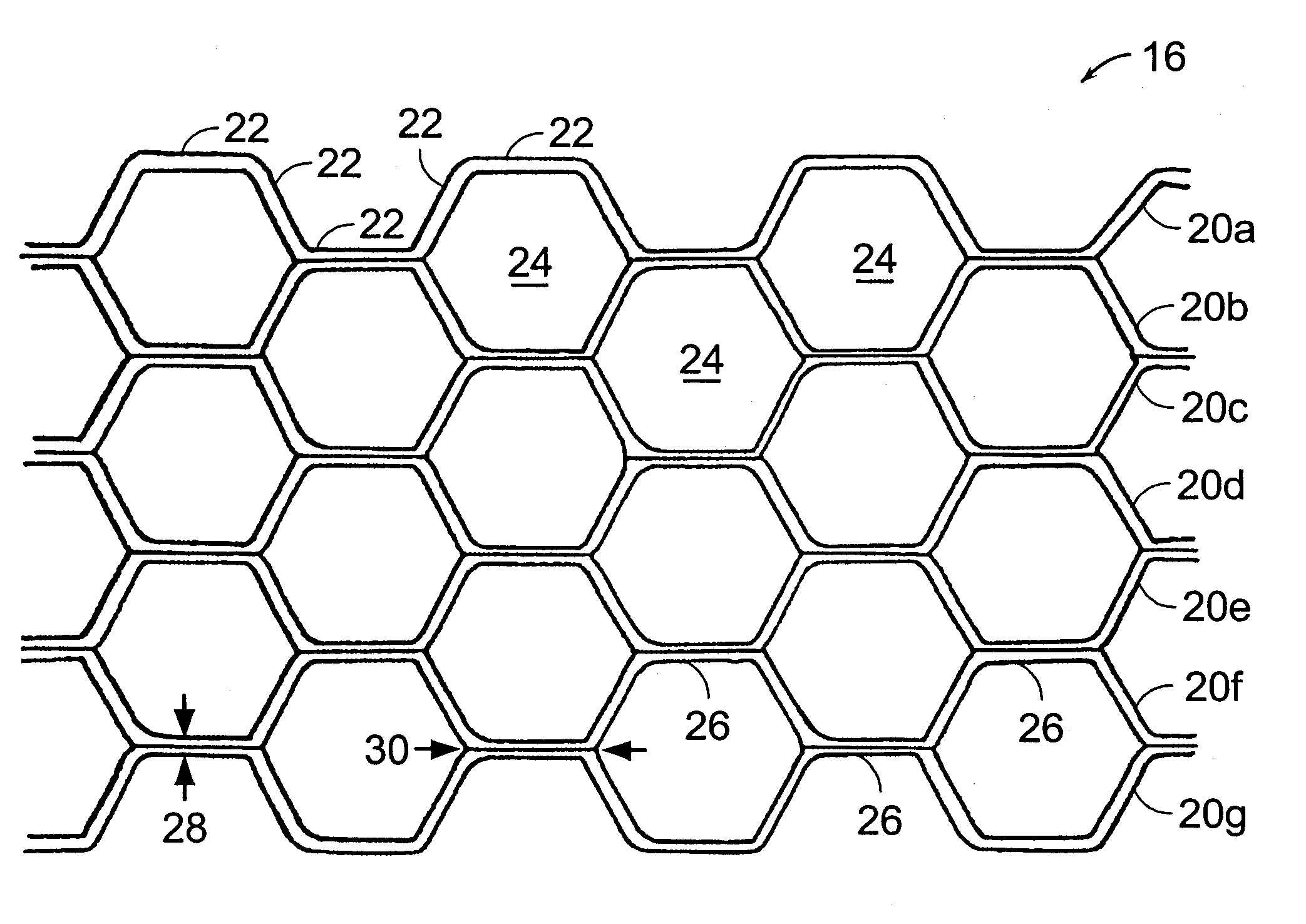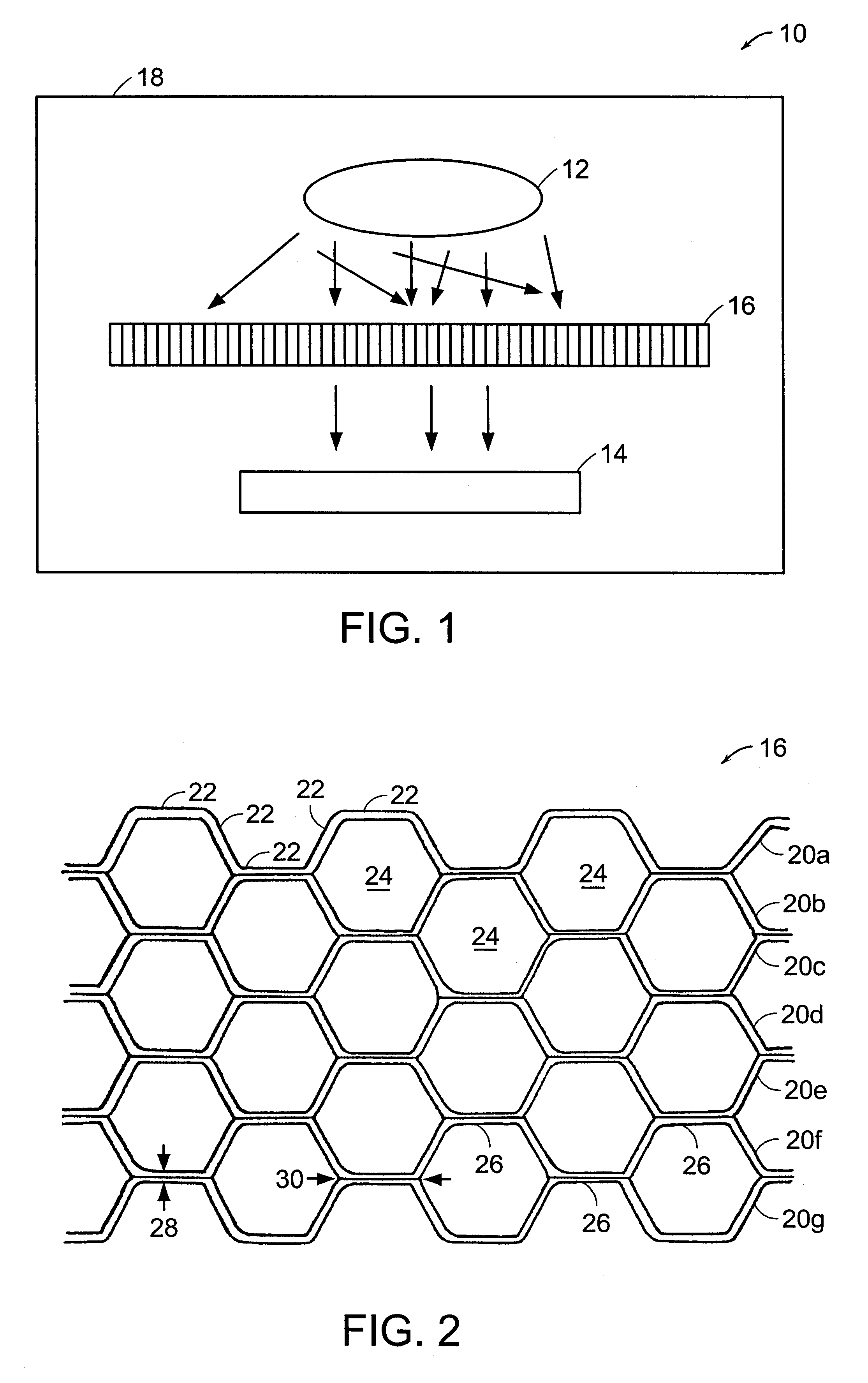Brazed honeycomb collimator
a collimator and honeycomb technology, applied in the field of honeycomb collimators, can solve the problems of excessive blockage of sputtered atoms traveling, large amount of waste material, and high production cos
- Summary
- Abstract
- Description
- Claims
- Application Information
AI Technical Summary
Problems solved by technology
Method used
Image
Examples
example 1
A collimator was manufactured from stainless steel 316L material (0.03C-2.0Cr-1.0Si16 / 18Cr-10 / 14Ni-0.045P-0.03S) by resistance spot welding corrugating ribbons to created a nested honeycomb pattern substantially similar to that depicted in FIG. 2. The ribbons were formed from 0.038 cm (0.015 inch) thick stock having a width of about 1.59 cm (0.625 inches). After welding, the collimator was cleaned by soaking first in acetone, then in alcohol, followed by air drying. AMS 4782 E, Mesh 140, braze powder (Ni71, Cr19, Si10) available from Wall Colmony Corporation located in Madison Heights, Michigan was mixed with Nicrobraz S binder, also available from Wall Colmony Corporation, in the recommended 10:1 ratio to form a thick slurry. The slurry was manually applied to the diverging wall portions of the collimator by extrusion through a syringe with a tip diameter of about 0.083 cm (0.033 inches). The binder was allowed to air dry. No flux was used due to the possibility of interaction with...
example 2
A collimator was manufactured from titanium CP Grade 4 material (Ti, <0.4O, <0.5Fe) by resistance spot welding corrugating ribbons to created a nested honeycomb pattern substantially similar in configuration to that discussed in Example 1. TiCu15Ni15 braze powder available from WESGO Metals Division located in Melrose, Massachusetts was mixed with Nicrobraz S or Vitta FC 15 binders, the latter available from Vitta Corporation located in Bethel, Connecticut, in the recommended 3:1 ratio to form thick slurries. The slurries were manually applied to the diverging wall portions of several collimators by extrusion through a syringe.
The vacuum furnace and graphite fixturing were prepared by loading the fixturing into the furnace, sealing the furnace, and pumping the furnace down to below about 5.times.10.sup.-4 Torr vacuum. The furnace was heated to about 1260.degree. C. (2300.degree. F.) at a rate of about 11 to 17.degree. C. / min (20 to 30.degree. F. / min) and held at temperature for abou...
example 3
A stainless steel collimator similar to that discussed in Example 1 was prepared for brazing by application of the braze material using a Binks Model 180 spray gun available from Binks Manufacturing Company located in Franklin Park, Illinois. AMS 4782 E, Mesh 140, braze powder and Nicrobraz 520 binder, also available from Wall Colmony Corporation, were added to the appropriate containers in the spray gun. The gun was adjusted to exhibit a pattern of binder and alloy on a smooth surface wherein the alloy sticks to the surface without excessive wetting by the binder which would cause the braze material to run when applied to a vertical surface. The collimator was sprayed in several passes along the ribbon direction with the spray gun held at about a 45 degree angle as discussed hereinabove with respect to FIG. 3. The collimator was inverted and the process repeated. The collimator was weighed before and after application of the braze material to quantify the average weight of braze ma...
PUM
| Property | Measurement | Unit |
|---|---|---|
| temperatures | aaaaa | aaaaa |
| included angle | aaaaa | aaaaa |
| angle | aaaaa | aaaaa |
Abstract
Description
Claims
Application Information
 Login to View More
Login to View More - R&D
- Intellectual Property
- Life Sciences
- Materials
- Tech Scout
- Unparalleled Data Quality
- Higher Quality Content
- 60% Fewer Hallucinations
Browse by: Latest US Patents, China's latest patents, Technical Efficacy Thesaurus, Application Domain, Technology Topic, Popular Technical Reports.
© 2025 PatSnap. All rights reserved.Legal|Privacy policy|Modern Slavery Act Transparency Statement|Sitemap|About US| Contact US: help@patsnap.com



